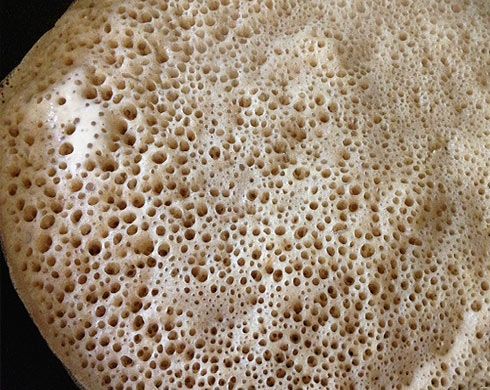Injera
Diversify your kitchen with Ethiopian injera!
Injera is a flat bread and is characterized by being soft and spongy. It is a national food in Ethiopia and in Eritrea and is consumed daily in both countries. To properly eat injera you have to use your right hand only. Injera is used in place of silverware, as a plate and sometimes even as a table. Small pieces are torn and used to scoop up a variety of meats, vegetables, stews and salads. The main ingredient in Injera is teff flour. Teff flour is high in fiber and iron. In Ethiopia teff flour is the main ingredient used in the bread. In the United States injera bread tends to have a mixture of all-purpose flour or whole wheat flour, in place of the large amounts teff flour that is traditionally used. Injera comes in different varieties in Ethiopia such as white, red or black.
characterized by being soft and spongy. It is a national food in Ethiopia and in Eritrea and is consumed daily in both countries. To properly eat injera you have to use your right hand only. Injera is used in place of silverware, as a plate and sometimes even as a table. Small pieces are torn and used to scoop up a variety of meats, vegetables, stews and salads. The main ingredient in Injera is teff flour. Teff flour is high in fiber and iron. In Ethiopia teff flour is the main ingredient used in the bread. In the United States injera bread tends to have a mixture of all-purpose flour or whole wheat flour, in place of the large amounts teff flour that is traditionally used. Injera comes in different varieties in Ethiopia such as white, red or black.
To buy teff flour locally you should try grocery stores such as Whole Foods. The Blue Nile restaurant in Ferndale, Mich. is a traditional Ethiopian restaurant that serves injera; it is served lining the plate and soaks up the sauces from the foods that are served on top of it. Similar types of bread are eaten in surrounding countries such as Somalia, Sudan and Yemen.
Michigan State University Extension encourages you to try the below recipe for Ethiopian injera.
Ethiopian injera
Ingredients
1/4 cup of Neff flour
3/4 cup of all-purpose flour
1 cup of water
A pinch of salt
Peanut or vegetable oil
Mixing bowl
Non-stick skillet or cast iron skillet
Directions
1. Put the teff flour in the bottom of a mixing bowl and sift in the all-purpose flour.
2. Slowly add the water, stirring to avoid lumps.
3. Put the batter aside for a day or more (up to three days) to allow it to ferment. In this time, your injera batter will start to bubble and acquire the slight tanginess for which it’s known. Note: If you find that your injera batter does not ferment on its own, try adding a teaspoon of yeast.
4. Stir in the salt.
5. Heat a nonstick pan or lightly oiled cast-iron skillet until a water drop dances on the surface. Make sure the surface of the pan is smooth; otherwise your injera might fall apart when you try to remove it.
6. Coat the pan with a thin layer of batter. Injera should be thicker than a crêpe, but not as thick as a traditional pancake. It will rise slightly when it heats.
7. Cook until holes appear on the surface of the bread. Once the surface is dry, remove the bread from the pan and let it cool.



 Print
Print Email
Email


